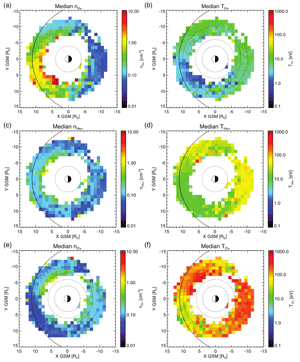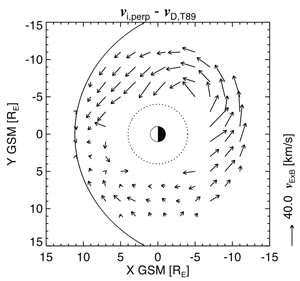
2014 THEMIS SCIENCE NUGGETS
On the presence and properties of cold ions near Earth's equatorial magnetosphere
Justin H. Lee, UCLA EPSS & IGPP
Introduction
Cold ions are a fundamental charged particle population of the Earth's magnetosphere. They originate from both solar and terrestrial sources and populate different magnetospheric regions in processes dependent on the large-scale configuration of the interplanetary magnetic field. Cold ions are difficult to observe due to their low total energy, usually too low to be detected above the effects of spacecraft positive charging in sunlight. Because of this charging, cold ions and their properties cannot be measured by particle instrumentation most of the time.
Some recent work using multiple complementary cold ion detection methods has painted a partial picture of how pervasive cold ions can be far above the polar caps and into the magnetotail, as well as near the dayside magnetopause [Engwall et al., 2009; André and Cully, 2012]. But large regions of space spanning both dayside and nightside equatorial locations beyond the plasmasphere have been missing from this picture--until now.
| Figure 1. Median density and temperatures for protons (a and b), helium ions (c and d), and oxygen ions (e and f). |
Results
Natural bulk plasma flow phenomena (convection and ULF waves) sometimes accelerate the plasma enough so that cold ions' kinetic energies can overcome the spacecraft potential barrier and they can then be measured by charged particle instrumentation. If multiple ion species are present during these bulk plasma flows, they also separate by mass number in particle flux data. By utilizing measurements made by the three inner THEMIS spacecraft during such times, we surveyed cold ion (protons, helium ions, and oxygen ions) compositional properties throughout the equatorial magnetosphere. What we found were distributions of cold ion densities and temperatures that changed with magnetic local time (MLT) sector, shown in Figure 1. Oxygen ions appeared to be the most abundant cold ion on the nightside and were warmest there, suggesting a link to a nightside ionosphere source and additional heating by injections or waves. The abundance ratios of all three species changed on approach to the dayside, showing that additional sources contribute to population of the dayside.
| Figure 2. The resulting cold particle flow pattern consistent with E × B drift after subtraction of the estimated diamagnetic particle drift component calculated using a realistic geomagnetic field model (vD,T89) from the measured total ion flow (vi,perp). |
By subtracting an estimate of the energetic component of measured ion flows we also showed how equatorial cold particles are transported mostly sunwards by convection and that this motion is distorted nearer Earth by corotation, depicted in Figure 2. The figure shows that cold ions stagnate near pre-midnight and from there mostly flow along the dawnside with less flowing through along dusk, in agreement with early particle transport modeling.
Discussion
Our results add to the existing database on cold ion composition and properties and draw renewed attention to their sources, transport, as well as their participation in other physical processes. The results can be applied to future studies on reconnection at the magnetopause and the magnetotail and are also important to consider for studies on wave-particle interactions.
Reference
André, M., and C. M. Cully (2012), Low-energy ions: A previously hidden solar system particle population, Geophys. Res. Lett., 39, L03101, doi:10.1029/2011GL050242.Engwall, E., A. I. Eriksson, C. M. Cully, M. André, P. A. Puhl-Quinn, H. Vaith, and R. Torbert (2009), Survey of cold ionospheric outflows in the magnetotail, Ann. Geophys., 27, 3185–3201, doi:10.5194/angeo-27-3185-2009.
Lee, J. H., and V. Angelopoulos (2014), On the presence and properties of cold ions near Earth's equatorial magnetosphere, J. Geophys. Res. Space Physics, 119, doi:10.1002/2013JA019305.
Biographical Note
Justin Lee is a graduate student in the Experimental Space Physics Group at UCLA and works with Professor Vassilis Angelopoulos. He is interested in the presence of multiple ion species in the Earth's magnetosphere and how they interact with electromagnetic ion cyclotron (EMIC) waves. He studies this topic using a combination of THEMIS spacecraft data and modeling.
 Please send comments/suggestions to
Emmanuel Masongsong / emasongsong @ igpp.ucla.edu
Please send comments/suggestions to
Emmanuel Masongsong / emasongsong @ igpp.ucla.edu


